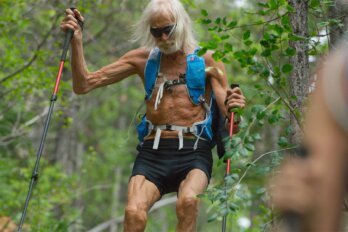When Cam McQueen was in grade ten, he was required to take “Career and Personal Planning,” one of those high school courses that encourage teenagers to think about what they’ll do with their lives after they graduate. McQueen, a gearhead from birth who’d been building off-road vehicles in his family garage for years, already had devoted much thought to the subject. In his term paper, he explained that he would become a monster-truck driver. He’d even gone out and interviewed industry veterans, educated himself about their earnings and working conditions, and made a business case to show how he could support himself on monster-truck wages.
His teacher flunked him. “Monster-truck driver”—like astronaut, pro hockey player, supermodel, video game tester, and marijuana sommelier—is exactly the kind of silly, juvenile pipe-dream employment path that students are supposed to forget about. Real life is about becoming a nurse or an oil-field worker; not screaming yee-haw as you roll 10,000 pounds of steel over the corpse of some junkyard Toyota.
Two decades later, McQueen still has that term paper tucked away in a box of high school documents. Maybe one day, he’ll find his old Career and Personal Planning teacher and show it to him. Of all the students in that 1996 high school class, McQueen might be the only one who predicted his future career path with such accuracy.
McQueen—who now lives in Kelowna, BC—drives Northern Nightmare, the flagship Canadian entry in the Maple Leaf Monster Jam Tour, which began its 2015 stadium run this past weekend in Toronto. (Coming events will take place in Edmonton, Winnipeg, Vancouver, London, Hamilton, Halifax, and Calgary.) In the competitive, truck-crush-car world of monster trucking, he established himself as a bona fide superstar three years ago by winning the 2012 World Freestyle Championship at the Monster Jam Finals in Las Vegas.
The sport now known as monster trucking has been around, in some form, since the early Cold War period, when hobbyists put oversize tires on conventional pickup frames and raced them in off-road competitions. (To this day, McQueen tells me, some of the sport’s most passionate fans live in Florida’s panhandle, where swamp-buggy tech culture came of age.) A seminal moment arrived in the early 1980s, when driver Bob Chandler got the idea of driving his truck “Bigfoot” over old cars—an aspect of truck shows that we now take for granted, but which was then seen as a novel bit of showmanship. Crowds went wild for it, and the idea of the “monster truck”—a massive vehicular predator that runs roughshod over its non-monster brethren—was born.
“When I talk to kids at the pit parties”—the public events where monster-truck fans meet drivers and admire their vehicles—“they often tell me that what really excites them about the shows is the car-stomping,” McQueen tells me during an arena-side interview the day before his Toronto Monster Jam show. “That’s what they want to see. But I also view it, in a way, as a form of recycling. These cars are destined for the junkyard, where they’re going to be crushed and processed. We do something useful with them first. And we take care of the crushing part.”
But surely it’s not just the children who long to see this specific type of mayhem, I suggest to McQueen. For parents, does this scenario not represent, in some larger symbolic sense, the crushing of bourgeois norms by a romantic maverick who refuses to obey society’s regimented conventions? Many of the most popular monster trucks, I note, have names that evoke outlaw motifs—El Diablo, Bounty Hunter, El Toro Loco, Menace, The Felon, Scarlett Bandit, Grave Digger.
“Yes, that is part of the fantasy,” McQueen tells me, after patiently listening to my theories. “When I sit in my monster truck, I definitely think that this would be a cool thing to have when it’s rush hour on the highway. I’m sure a lot of the fans are having similar thoughts.”
Ironically, while the aesthetics of monster trucking glorify reckless vehicular carnage, the sport itself has become quite safe at the professional level. Engines and tires are standardized (1,500 horsepower for the former, sixty-six-inches high for the latter). And the construction of every touring monster truck chassis incorporates state-of-the-art safety-cage technology. McQueen, like other drivers, is strapped into a HANS device to protect his head and neck in the event of a crash. His engine and fuel line are equipped with redundant kill switches to guard against fires and explosions—including a remote control switch operated by track officials. All of the at-risk components (including the massive wheels) are secured to the chassis by steel cables, to ensure they don’t fly into the crowd after a crash.
Earlier in this piece, I used the term yee-haw to evoke the redneck stereotype that many of us hold in regard to monster trucking, which often is stigmatized by non-fans as the professional wrestling of the motorsport world. But at the highest level, the sport is technically demanding. (McQueen himself spent time studying mechanical engineering before he became a professional monster trucker, and tells me that the physics and material-science courses help him understand the way his truck navigates a course and responds to unexpected impacts.) In most forms of motorsport, a vehicle’s engineering is directed at keeping the wheels clinging tight to the track surface. But monster trucks also are designed to survive massive jumps over, and onto, irregularly shaped obstacles such as vans and large earthen mounds. The monster-truck driver’s challenges take place in three dimensions, not two, since every aerial manoeuvre presents a risk of rollover.
And there’s another complicating factor, too. “For a driver coming to monster trucks from another motor sport, perhaps the biggest skillset adjustment would be the limited visibility—the difficulty in knowing where the vehicle is in relation to the environment,” McQueen tells me. To demonstrate, he instructs me up to climb up into the driver’s seat of Northern Nightmare (a difficult activity, which requires me to shimmy through the space between the fibreglass truck body and the steel safety truss), and plant my skull into the back of the protective headrest.
Having done so, I immediately see his point: because the truck is high off the ground, the hood blocks out the ten meters of real estate that lie directly in front of the vehicle. It registers on me that monster-truck drivers can’t actually see the jumps and trashed cars they’re rolling over at the time they’re rolling over them—they have to rely on their mental mapping of the course. Moreover, the tight restraints imposed by the HANS device restrict the driver from moving his head laterally by more than inch or so—which means he can’t see much out of the sides of the truck either.
And there’s another aspect of monster-truck racing that would bamboozle an interloper from NASCAR or Formula 1: all four tires of a monster truck are steered in tight corners, and not always in the same direction. To the right of the steering wheel is a pistol grip that allows McQueen to turn the rear tires in the opposite direction of the front ones—as with an articulated construction vehicle. During complex manoeuvres, Northern Nightmare’s pilot needs to operate the steering wheel, pivot the rear tires, and shift gears in a carefully synchronized way (the truck uses a two-speed Powerglide transmission, similar to those used in drag-racers). Any mistake, and McQueen is bottom-side up, crawling out of his truck window.
“This isn’t just a jacked up F-150,” he tells me. “Under the hood is a fully engineered custom built competition machine. A lot of folks imagine that you get into a monster truck, hit the throttle, and away you go. I’d challenge anyone to do a lap at full speed in one of these trucks and see how they do.”
*
One of the best-known monster-truck send ups came in an early Simpsons episode (“Bart the Daredevil”—originally aired December 6, 1990), featuring the fabled Truckosaurus—“twenty tons and four stories of car-crunching, fire-breathing, prehistoric insanity.”
“If you miss this, you’d better be dead . . . or in jail,” the breathless television announcer informs Bart. “And if you’re in jail, break out!”
Having never before been to an actual monster-truck event, I expected that this would be the spirit of half-crazed metallurgical bloodlust being promoted through the loudspeakers when I took my children to the Monster Jam show on Saturday night at Toronto’s Rogers Centre. But the reality is more understated and less menacing than satire suggests. None of the trucks eat other trucks. There are no staged taunting sessions, as in professional wrestling. Most of the drivers, McQueen told me, really like each other.
That said, showmanship is a big part of monster-truck culture. El Loco Toro snorts smoke when it does something cool. Scooby-Doo has a giant tail. Mohawk Warrior has a giant (you guessed it) mohawk. A retired female FedEx driver from Michigan named Shelley Kujat drives a monsterized 1972 Chevy El Camino with “Girls rock!” emblazoned on the side. By comparison, McQueen’s truck has a markedly understated and tasteful red-and-black design with no gimmicky appendages. On the night I attended, when he stepped out of his vehicle to address the crowd, McQueen went on and on about how much he respected the other drivers; he politely thanked his mechanics for all their hard work. All to say: it’s hard to imagine a more gentlemanly monster trucker than Cam McQueen. He’s like the Jean Beliveau of car crushing.
The Monster Jam tour shows feature a round of one-on-one monster-truck races, followed by a Motocross-bike halftime show, and a halftime competition featuring souped-up, ordinary pickup trucks (they look puny and pathetic next to their monster counterparts). Then comes the highlight—the freestyle competition, in which the trucks each have two minutes to zip around the course, jumping, crushing, and dirt-spinning the audience into overdrive frenzy. The performances are evaluated by judges holding up placards with numbers on them—like in an old-fashioned figure-skating competition.
This is where you see the drivers pushing their monster trucks to the limit of engineering design, and not all of them prove up to the task. Krazy Train busts a front tire and limps to the finish line. Shelley Kujat’s Shell-Camino stalls, spewing fluid out of its rear differential housing. Grave Digger starts the program with a gigantic jump, and promptly busts its front wheel assembly. Maximum Destruction, an especially fearsome-looking front-engine beast driven by legendary trucker Tom Meents, has a great run, but ends upside down.
Then comes Northern Nightmare. McQueen wastes no time, blasting straight to the arena’s central platform, shooting up into the air, and then landing his truck ass-heavy onto a car, using the crushing force of the movement to propel himself forward into a four-point landing—a beautiful technical accomplishment. Then another series of massive jumps, including one that sends him spinning up onto his right-side wheels. For a moment, it looks like he’ll flip, ending his night. But he corrects in the nick of time, gets back upright to wild cheers, and slams Northern Nightmare hard into a steep wall of dirt, propelling his truck into an almost vertical position, then up and over his target. In the final seconds, when it’s clear he’s won, McQueen adds a few front and back wheelies as grace notes. Thirty-thousand-plus monster-truck fans cheer as he is crowned the evening’s freestyle winner.
*
Monster trucking isn’t making Cam McQueen rich. (Between Monster Jam tours, he told me, McQueen still sometimes takes construction jobs back home in BC.) Nor does he have much job security: he competes in the Monster Jam as an employee of its production company, Feld Entertainment Motor Sports, and can be replaced with another driver if he stops delivering the goods. Unlike an F1 driver, McQueen will never have a champagne fight on a podium in Monaco, or flirt with supermodels on Italian talk shows. But at the end of the day, the man is doing what he was born to do. And how many of us, no matter what we drive, can claim the same thing?




